Ancient Architecture Of The World
Suspension bridges and skyscrapers are marvels of modern engineering, but some of the world's most impressive constructions are thousands of years behind us. The Roman Colosseum is one such wonder of ancient architecture, marking a crucial transition point between two vastly different ages of construction.
➡ You love badass builds. So do we. Let's nerd out over them together.
For our list of the 20 most impressive ancient achitecture builds (at least ones that are still partially around) we'll use the Great Wall of China as our starting point and dip further back in time to explore the depth and breadth of building before the common era.
The Great Wall of China
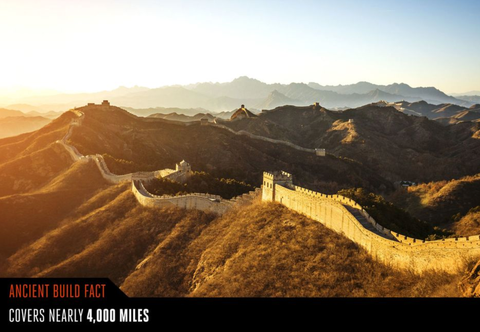
Public Domain
Northern China, 210 B.C.
Nobody wants barbarians from the north entering their land. That's why Chinese Emperor Qin Shi Huang commissioned the start of what is now the Great Wall of China in the third century B.C.
Made up of sections of walls that cover nearly 4,000 miles—not including another roughly 1,500 miles of natural barriers—the east-west wall uses stone, brick, wood, and earth to create a physical and psychological barrier. Much of the original wall didn't stand the test of time, but the Ming dynasty in the 1300s started a building push that made the Great Wall the wonder it is today.
Temple of Hera
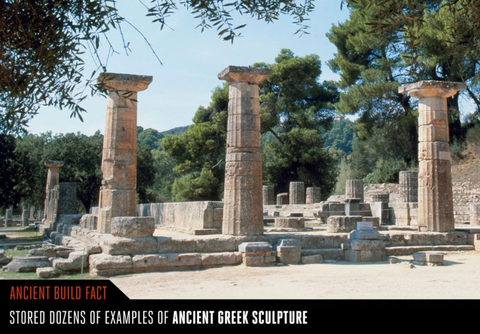
Public Domain
Italy, 550 B.C.
Originally surrounded by 40 stone columns (originally wood) the Doric style exterior of the low-slung Temple of Hera was built on the south slopes of Kronos hill, complete with three distinct interior chambers. Interior walls broke up worship areas for different Greek gods, rooms which later became a home for some of Rome's ancient relics.
The temple has a limestone base which runs east to west, longer than it is wide. Mud bricks, meanwhile, form the upper portion with wood and terracotta adorning the temple's interior. Unfortunately, most of it was destroyed during an earthquake in the 4th century AD.
Ancient Greek Parthenon on the Acropolis
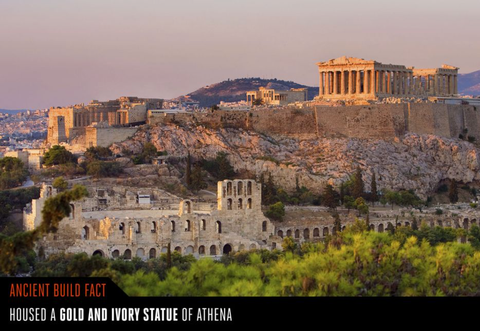
Public Domain
Athens, 432 B.C.
The first buildings constructed on the the rocky outcrop of the Acropolis of Athens were destroyed by Persians around 480 B.C., but that didn't stop a second 15-year effort from finishing a complete reconstruction that wrapped up around 432 B.C. The highlight of the Acropolis was the Parthenon and its gold and ivory statue of Athena, but there was plenty of other stuff to see, including the limestone foundation and columns made from Pentelic marble, an early use of the material.
Gobekli Tepe
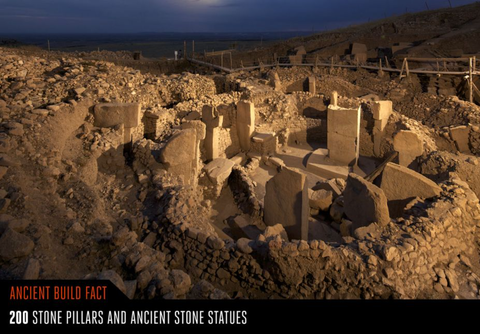
Public Domain
Turkey, 9000 B.C.
Considered to be the world's first temple, the Gobekli Tepe contains at least 20 circular installations that contain several pillars surrounded by walls, some 200 pillars throughout the whole temple. The site is also home to rock statues with carvings of animals—foxes, snakes, wild boars, cranes and wild ducks—that could date back as far as 10,000 BC. Perhaps most interestingly, some of the construction features pillars that are T-shaped and weigh over 60 tons, leaving experts unsure of how such primitive humans accomplished such a difficult and complex task.
Tumulus of Bougon
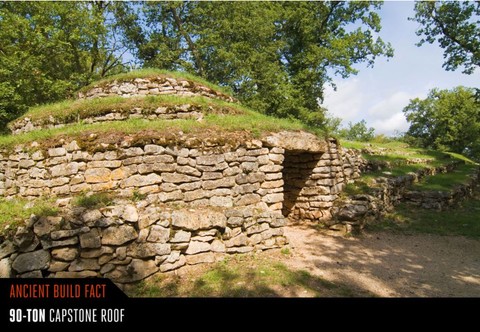
Public Domain
France, 4700 B.C.
On a limestone plateau near the river Bougon is a stepped mound with a rectangular chamber, the Tumulus of Bougon. Inside the ancient mound is a series of passages and chamber walls formed by human-shaped orthostats, or more simply "upright stones." A 90-ton capstone covers the main chamber, with the monolithic pillars dividing the room up into smaller subsections.
When discovered, the location was filled with several vertical layers of skeletons and lots of pottery, which helped archaeologists identify the timeline of construction and discover just how early and impressive this structure is.
Stonehenge
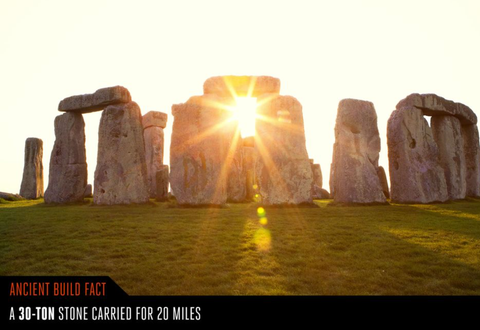
Public Domain
England, 3000 B.C.
The widely famous Stonehenge is built from a mix of large sarsen stones—a type of sandstone found naturally in the south of England—and smaller bluestones. The largest sarsen stone, believed to be from Marlborough Downs about 20 miles from the site, weighs about 30 tons. The Wales-derived blue stones weigh between two and five tons each and were likely carried over 150 miles to reach their final resting place at the Stonehenge site.
Carnac stones
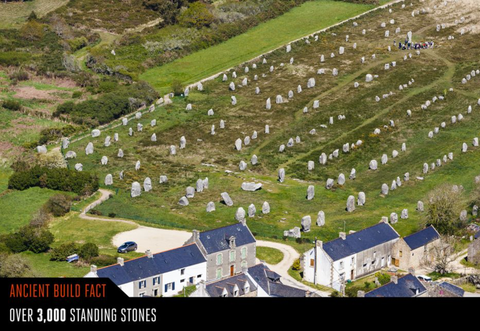
Public Domain
France, 3300 B.C.
Does the year 3300 B.C. sound a little too recent for the world's largest collection of standing stones? It's actually a relatively conservative guess. Some historians believe some of the stones that form the array known as the Carnac Stones in the Brittany region of France date all the way back to 4500 B.C.
Many have guessed at the possible purpose of the megalithic site, which may have been used to track to movement of the sun or the stars. We may never really know, but the sheer intensity of hundreds and hundreds of carved stones placed in such a regimented order is compelling food for speculation.
Knap of Howar
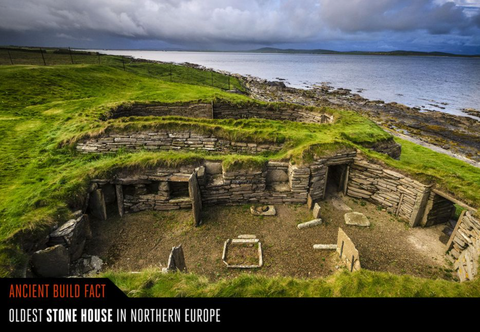
Public Domain
Scotland, 3700 B.C.
It may seem like just a stone house, but the Knap of Howar in Scotland is actually the oldest preserved stone house in northern Europe. The farmstead's two buildings connected by a passage were built with split stone to a height of just over five feet and feature doorways facing the sea. A hole in the roof indicates the home was likely heated by fire and stone furniture found provides an even stronger indication that this was once an ancient residence.
Megalithic Temples
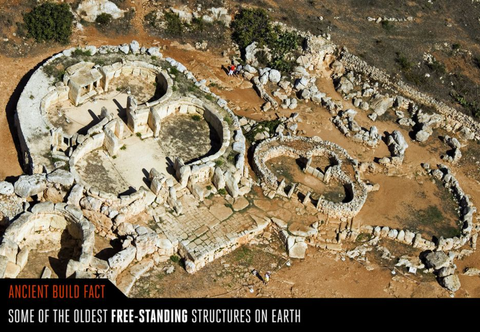
Public Domain
Malta, 3,500 B.C.
A collection of six different temples built over hundreds of years in Malta, the Megalithic Temples are noteworthy not only for their originality and complexity, but due to the advanced technical skill that would have been required to build some of the earliest known freestanding stone structures. Each monument had a different articulation and construction, and the exteriors were often hard coralline limestone, while softer globigerina limestone use used for a more delicate and ornate interior.
Newgrange
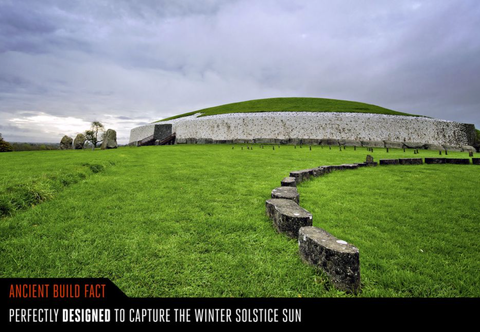
Public Domain
Ireland, 3200 B.C.
On roughly 4 days every year, the winter solstice sun pokes through the top of this Stone Age monument and onto the floor of the interior chamber, filling the ancient temple with light for about 17 minutes. Built before Stonehenge, Newgrange was likely used to track the passing of the years with a precision ahead of its time. With an earthen mound and stone forming passageways and chambers inside Newgrange, the site likely also served as a passage tomb and ceremonial location as well as highly engineered clock.
Sechin Bajo

Public Domain
Peru, 1300 B.C.
The vast majority of the world's most imposing ancient structures are found in the Eastern Hemisphere, but Peru's Sechin Bajo can't be overlooked. One of the oldest archaeological sites in the Americas, the valley-based civilization's impressive build was opened up to the world in 2008 after the discovery of a circular adobe brick and rock plaza over 30 feet in diameter. That, along with a nearby frieze standing over six feet tall served as archeologists' first look at the area.
Eventually, additional buildings with platforms, circular plazas, sunken features, friezes, graveyards, and walls with carvings have been uncovered, many built with pre-ceramic materials.
Theatre of Marcellus
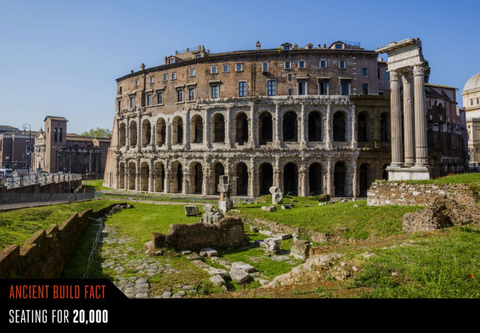
Public Domain
Rome, 12 B.C.
Rome's Theatre of Marcellus has a star-studded past. Commissioned by Julius Caesar and later inaugurated by Augustus, the architecture of the columned building became the template for countless theaters and stadiums to follow. The Theatre of Marcellus was an open-air venue that could hold 20,000 spectators and included a semicircular travertine façade, arches, Doric columns, and three levels of seating. The intricate design included stairways, ramps and even an open-air backdrop seen behind the stage.
Aqueduct of Segovia

Public Domain
Segovia, Spain, 50 A.D.
It's the useful things that tend to be the best preserved, which is why the crucial Aqueduct of Segovia in Spain is one of the best surviving examples of an ancient aqueduct. Likely build around 50 A.D., just a few decades before the Colosseum, it was carrying water from the Frio River to the Spanish town of Segovia into the 1900s.
Made of 24,000 granite blocks—and no mortar, mind you—it covers over eight miles of undulating landscape. With 165 arches that reach over 30 feet high, the two-story aqueduct was built with great precision, which is why it's still around today.
Roman Coliseum
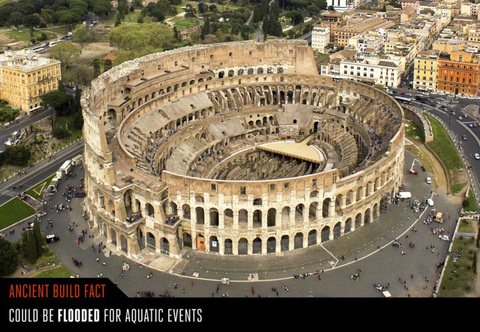
Public Domain
Rome, 80 A.D.
At 620 feet long and 513 feet wide, the Colosseum in Rome was easily the largest amphitheater around when it was in its prime, yet it wasn't built into a hillside for support like many other large structures of the time. Instead, it was a fully freestanding stadium with a foundation of concrete and stone that could provide seating for 50,000 visitors in multiple seating configurations and levels. On top of that, the Colosseum's 80 awning-covered arches lead visitors into an arena that was so well-engineered that it could even be flooded with water to support aquatic events.
La Hougue Bie

Public Domain
Jersey, 3500 B.C.
The La Hougue Bie on the island of Jersey off the coast of Normandy, France, has a two histories. When it was first built around 3500 BC it served as a passage grave, one of the tallest in Europe. It was also a religious site, marked by a medieval chapel sitting atop the prehistoric mound dolmen—a grave marked by upright stone. Then, in its second life, it was home to a command bunker built during the German Occupation of World War II.
The Egyptian Pyramids
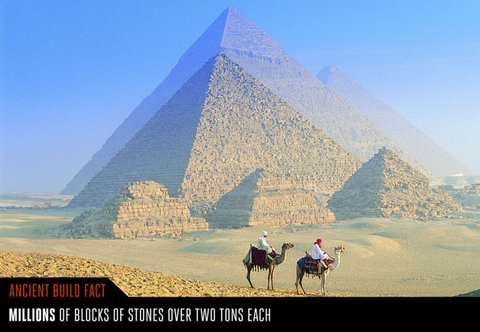
Public Domain
Egypt, Centuries around 2500 B.C.
Nothing showcased the might of Egypt's Old Kingdom better than the powerful building effort of the late third dynasty pyramids, especially the majestic Great Sphinx of Giza built around 2530 B.C. Construction of pyramids really stepped up in 2600, when the mud-brick tombs started taking their iconic shape thanks to stepped layers of stone. They were, at the time, surrounded by shrines and courtyards, even temples. Where the original pyramid reached some 204 feet tall, the Great Pyramid of Khufu rose to over 481 feet and required millions of blocks of stone—about two and a half tons each. Each was hand-cut, and the whole process required thousands of workers to haul the materials into place.
Van Fortress

Public Domain
Turkey, 750 B.C.
Started in around 900 B.C. with construction finally wrapped over a century later, Van Fortress sits on a steep bluff that overlooks Tushpa, the ancient capital of Urartian near the modern city of Van in Turkey. With the lower portions of the walls made of unmortared basalt and mud bricks that form the remainder, Van Fortress is more a symbol of regional power more than one of military dominance, but has changed hands no less than a dozen times regardless.
This content is imported from {embed-name}. You may be able to find the same content in another format, or you may be able to find more information, at their web site.
Persepolis Gate of Nations
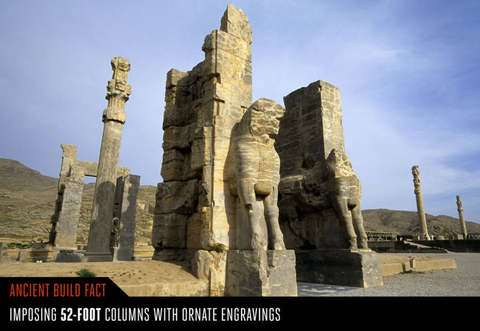
Public Domain
Persia (now Iran), 470 B.C.
Rituals designed to ward off evil in ancient Persia involved the use of bulls and the deity lamassu—a human head on an animal body with wings. And when King Xerxes set to building the Persepolis Gate of Nations, they played a part, as did imposing 52-foot columns with ornate engravings.
A pair of carved bulls marked the entrance on one end of the gate, while a carved lamassu decorated the opposite end. Not only were the size of carvings impressive for the time, but the detailing was also extravagant. A hall between the two carved gates led to a third, wider south entrance. The wooden interior pivoting doors were covered in metal, likely etched in much of the same style as the great hall.
Sanchi Stupa

Public Domain
India, 300 B.C.
The hemisphere-like shape known as the stupa is a common sight in Buddhist architecture, and Sanchi Stupa is perhaps the most famous of the ancient examples. One of the oldest stone structures in India, the stupa covering was built to shelter the remains of a Buddha. Carved gateways, doorways with storytelling carvings, additional staircases, and a top-level platform have been added in the hundreds of years since the memorial's initial construction in 300 BC.
Pons Fabricius
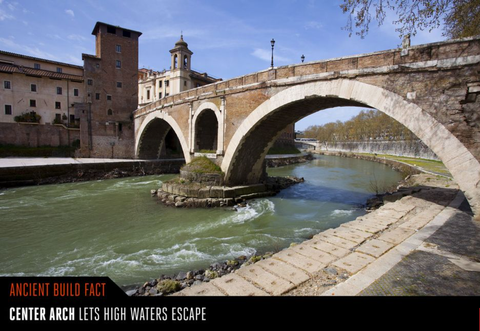
Public Domain
Rome, 62 B.C.
Pons Fabricius may not be the oldest bridge still in use (it's believed to be the second oldest) but it's maybe the most impressive. Spanning from the east bank of the Tiber River to Tiber Island in the middle, Pons Fabricius helps pedestrians stroll to the Theatre of Marcellus, detailed above. At 203 feet long and 18 feet wide, the stone arch bridge displays a bit of fanciful design on its two marble pillars.
Constructed with tuff and peperino stone (both a volcanic ash mixture) the bridge was once covered in travertine though now, thanks to repairs, there is some brick in there too. The cleverest part of the bridge's design is an additional arch in the center pier which gives high waters an escape route and alleviates pressure on the hefty foundation. That's no doubt a big factor in why it's still around today.
🎥 Now Watch This:
This content is created and maintained by a third party, and imported onto this page to help users provide their email addresses. You may be able to find more information about this and similar content at piano.io
Ancient Architecture Of The World
Source: https://www.popularmechanics.com/technology/infrastructure/a35867403/ancient-architecture/
Posted by: stampernernat.blogspot.com

0 Response to "Ancient Architecture Of The World"
Post a Comment